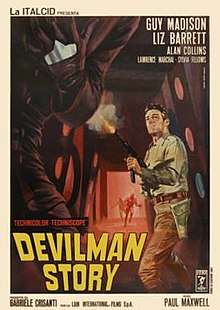The Devil's Man
The Devil's Man (Italian: Devilman Story) is a 1967 Italian science fiction film directed by Paolo Bianchini.
| The Devil's Man | |
|---|---|
 | |
| Directed by | Paolo Bianchini |
| Screenplay by |
|
| Story by |
|
| Starring |
|
| Music by | Patrick Leguy[1] |
| Cinematography | Aldo Greci[1] |
| Edited by | Constance Elliot[1] |
Production company | Lion International[1] |
Release date |
|
| Country | Italy[1] |
Cast
- Guy Madison as Mike Harway
- Liz Barrett as Christine Becker
- Alan Collins as Kew
- Diana Lorys as Yasmin
- Ken Wood as The Professor
Plot
Journalist Mike Harway decides to help his friend Christine Becker in her search for her father, professor Baker. Her father, a leading brain specialist, is in Rome for a conference but has mysteriously disappeared. After some time, their investigation brings them to Africa.
While in Africa as they're traversing a deserted they are captured by nomads and brought to the abandoned fort at El Faiu .
Within the fort is a hidden laboratory designed by the twisted mind of Devilman,
Devilman dreams of swapping his natural brain with an artificial one that he believes will make him perfect.
Mike, Christine and Professor Baker make a desperate attempt to escape from the fortress before the transfer occurs. The are rescued by an army of Moors.
Production
The Devil's Man was the first of three films director Paolo Bianchini directed for producer Gabriele Crisanti.[1] Crisanti stated that the film was designed to recover costs and recycle scenes from his other production I predoni del Sahara (1965) directed by Guido Malatesta.[1] Bianchini was allowed a lot of freedom while making the film, stating that Crisanti had already sold the title of the film and as long as he used footage he had of the riders from the previous film.[1]
Style
Film historian Roberto Curti noted that the film is often misleadingly described as a spy film.[1] Curti described it as mixture of "adventure, mystery and science fiction" that was closer to 1930s and 1940s American film serials.[1]
Reception
In a contemporary review, the Monthly Film Bulletin declared the film as a "routine formula of the power-crazed scientist whose manic schemes are thwarted by an inevitable final holocaust" while noting that the film had "some splendid desert locations and some "austere chrome and glass SF sets."[3]
Paolo Bianchini spoke negatively about the production and the film, stating that "Guy Madison was the only one who took the whole thing seriously. It was such crap!"[4] In Phil Hardy's book Science Fiction, The Devil's Man was referred to as a "routine mad scientist offering. The plot is so traditional that it wouldn't have been out of place in a thirties serial"[5] The review praised the sets of the film, specficially Devilman's secret laboratory noting that "as is so often the case in Italian science fiction films of the sixties, are delightfully futuristic."[5]
Home Release
As of June 2020 the movie is available on YouTube.[7] and was released on DVD with English subtitles.[8]
See also
References
Footnotes
- Curti 2016, p. 65.
- https://www.filmaffinity.com/en/film336942.html
- "Devilman Story (The Devil's Man)". Monthly Film Bulletin. Vol. 36 no. 424. British Film Institute. May 1969. p. 100.
- Curti 2016, p. 67.
- Hardy 1984, p. 262.
- The Devil's Man review. TV Guide. retrieved 6/16/20 https://www.tvguide.com/movies/the-devils-man/review/112893/
- https://www.youtube.com/watch?v=Ur8Y3hlmSlY
- https://dvdlady.com/dvd/the-devils-man-1969-with-english-subtitles-on-dvd/
Sources
- Curti, Roberto (2016). Diabolika: Supercriminals, Superheroes and the Comic Book Universe in Italian Cinema. Midnight Marquee Press. ISBN 978-1-936168-60-6.CS1 maint: ref=harv (link)
- Hardy, Phil, ed. (1984). Science Fiction. New York : Morrow. ISBN 978-0-688-00842-0.CS1 maint: ref=harv (link)